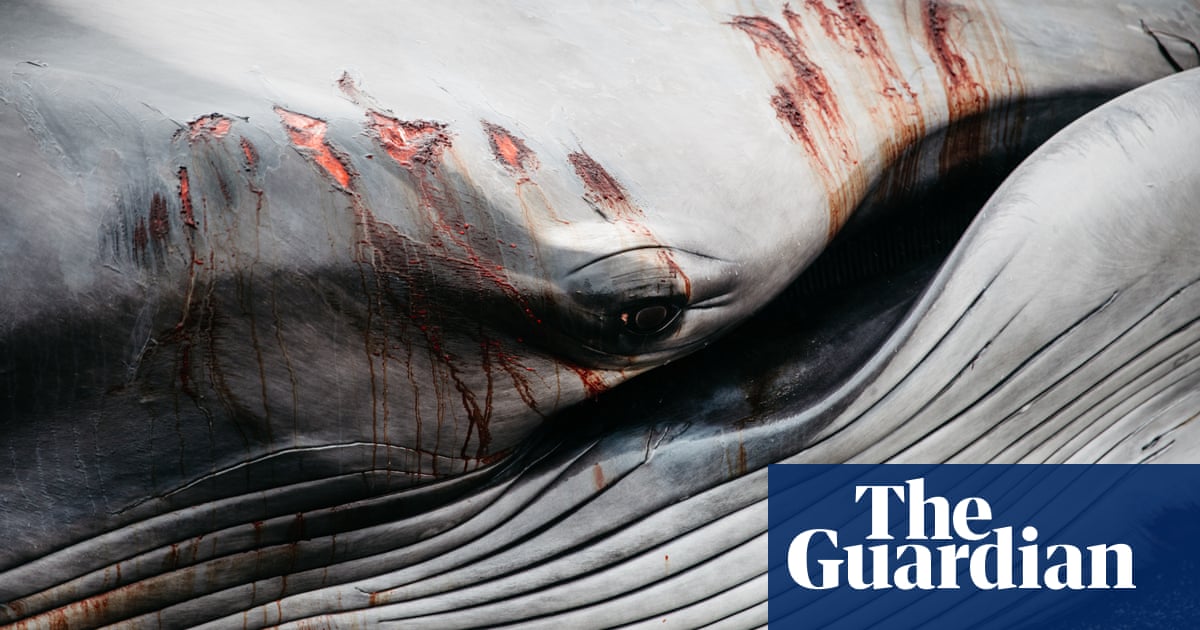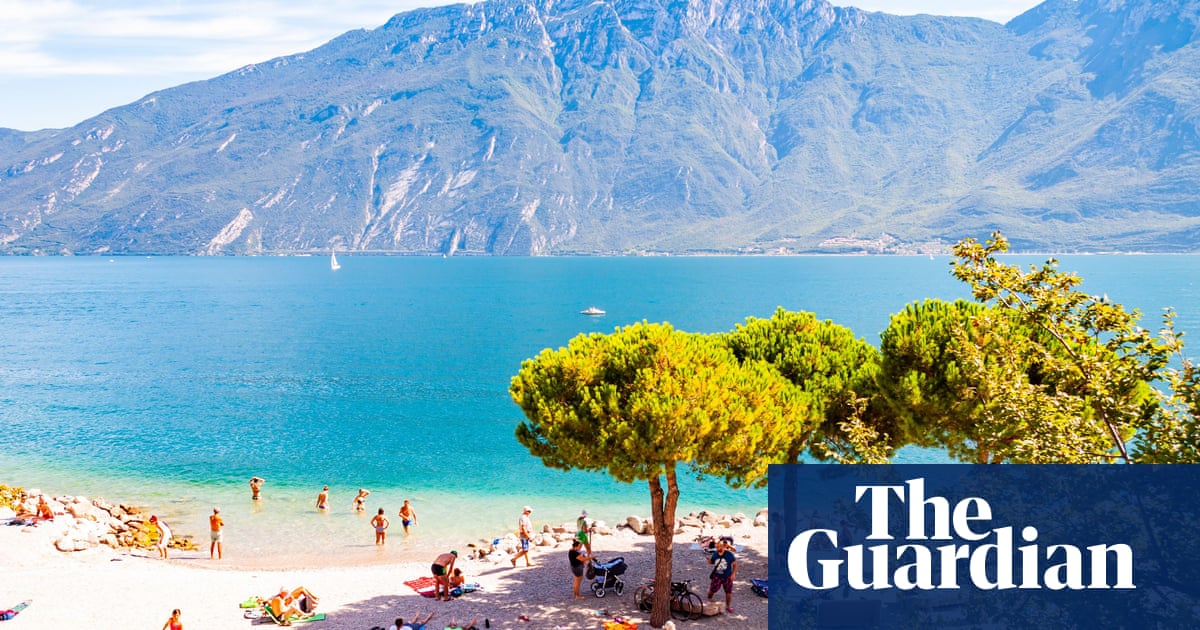
Awhale’s tail swishes high into the air, pausing at the apex of its stretch before beating down with a thud into the hard, rocky ground. The noise is sickening, the sound of two things coming together that were never supposed to meet. In the UK, encounters with megafauna are rare, so it is truly shocking to see this colossal creature stranded and gasping for air on the coast of Cornwall last March. We later find out it is a 19-metre (63ft), 80-tonne fin whale – the second largest creature on Earth.
Some of the first on the scene are members of the British Divers Marine Life Rescue service (BDMLR), one of several organisations called upon when a cetacean (whale, dolphin or porpoise) crashes on shore. In recent years, reports of cetacean strandings on UK coasts have reached record levels, with numerous mass strandings and a greater variety of species appearing on beaches. Already in 2023, there have been reports of a fin whale stranded in Cornwall in January and a stranded porpoise dying on the Yorkshire coast this month.
Since 1990, all cetacean strandings have been investigated by the UK Cetacean Strandings Investigation Programme (CSIP), jointly funded by the UK, Welsh and Scottish governments. Its findings indicate a changing marine environment where human influence is vastly affecting marine animals.
According to Rob Deaville, project manager at CSIP, the mean number of cetacean strandings rose to about 890 a year between 2015 and 2019, up from 570 from 2010 to 2014. Dr Andrew Brownlow, senior lecturer in veterinary epidemiology and director of the Scottish Marine Animal Stranding Scheme (SMASS), says: “Over the last five years, we’ve seen a year on year increase in the number of strandings. There are more animals that are being reported to us.”
For many of the scientists studying the health of cetacean populations, the link between the rise in strandings and increasing human activity in the seas is clear. “The large majority of strandings are inevitably attributed to negative anthropogenic impacts on the marine environment,” says Dr Kevin Robinson from the Cetacean Research and Rescue Unit, a marine conservation charity based in Scotland.
Evidence from the study of cetaceans and cetacean strandings can be used as a bellwether for the health of the seas. “Whales and dolphins are at the top of the food chain – their fortunes dictate the fortunes of the rest of the marine ecosystem. They are really good indicators of the health of the ecosystem and of the state of the marine environment,” says Dr Peter Evans, director of the Sea Watch Foundation and honorary professor at Bangor University.
Overfishing, bycatch, entanglement, shipping noise and traffic, shipping collisions and propeller strikes all impact negatively on cetacean species. In addition, commercial whale watching, naval activities such as low-frequency sonar and underwater explosions, oil and gas exploration, pile-driving, cable-laying, well-head decommissioning, poisoning, pollution and the climate crisis can cause strandings.
Strandings have, however, also happened throughout history due to natural causes such as illness, disease or injury. The job of CSIP is to identify the cause of the individual deaths they investigate. “There is certainly a degree of natural mortality, the question has always been are we seeing more or are we seeing different species, or are we seeing some that are due to what we are doing out there,” says Deaville.
Deaville singles out injury and death as a consequence of bycatch – the capture of non-target species while fishing – as “the main direct anthropogenic driver of mortality for 30 years in UK stranded cetaceans”.
“Bycatch is a major, major pressure on cetaceans globally,” he adds. CSIP data shows that between 1990 and 2019, of approximately 4,050 necropsies on cetaceans found on the UK shore that were in good enough condition to be examined, 782 diagnosed the after effects of bycatch and fishing gear entanglement as the primary cause of death, Deaville says.
Brownlow suggests the situation could be even worse than the numbers suggest. “There is potentially a huge amount of underreporting,” he says.
There is strong evidence that chemicals such as organochlorines – common ingredients in pesticides – and polychlorinated biphenyls (PCBs), a group of banned but still widespread and highly carcinogenic chemical compounds, have a highly toxic effect on cetacean health. “We are really worried about PCBs,” says Deaville. Despite being banned for several decades, their resistance to breaking down means much of what was produced has found its way into the oceans. “They have a really toxic effect on life,” says Deaville.
The worry for cetaceans in particular is that as PCBs move through the food chain, they “biomagnify”, becoming more concentrated and more toxic at each level. In 2016, a killer whale nicknamed Lulu was found dead on the Isle of Tiree in Scotland. She was found to have one of the highest concentrations of toxic pollutants ever recorded in a marine mammal, with a CSIP toxicology report showing an “astronomically high” PCB burden, which the team suspect may have prevented her from ever carrying young.
“We now think there are only a couple of west coast killer whales left,” says Deaville. “They have been studied for 30 years and they haven’t had a calf in that time. Lulu was a female that should have been happily having calves. She was about 20 and her ovaries showed no evidence of ever having cycled properly. Her levels of PCB were about 1,000mg per kilogram. At 10mg per kilogram you would possibly see some serious effects.” Deaville does not believe Britain’s west coast community can survive the levels of PCB pollution detected in Lulu. “It is our contention that what we did decades ago is contributing to a localised extirpation of the killer whale population … I think we are going to lose our killer whales around the UK coasts, probably within my lifetime.”
Despite the long list of anthropogenic factors that are routinely identified as contributing to the distress, trauma or death of many of the 24 species of cetacean that have stranded in UK waters since 1990, an increase in strandings alone may not necessarily indicate bad news in some instances “because it might mean there are more animals out there”, says Deaville.
“One of the potential reasons is the moratorium on commercial whaling that kicked in in the mid 1980s,” says Brownlow. “Effectively, we’re now 30 years downstream from that and the populations that we sought to protect are beginning to recover.” In 2008, humpback whales were downgraded by the International Union for Conservation of Nature to “least concern”.
In 2022, BDMLR received close to 3,000 calls about strandings on the UK coastline. In the case of a live stranding, the organisation’s team of trained volunteer medics assess whether a rescue attempt can be made. For a creature the size of a dolphin and in relatively good health, an attempt to refloat the animal can sometimes be made.
But rescue is not always possible. Back in Cornwall, when Dan Jarvis, director of welfare and conservation at BDMLR, approaches the stranded fin whale he can immediately tell the animal is malnourished. “It was in really poor nutritional condition so it had obviously spent some time not feeding – possibly due to an infection or illness,” he says.
The whale could not be saved and entered its death throes, opening its mouth wide and holding its tail in the air.












